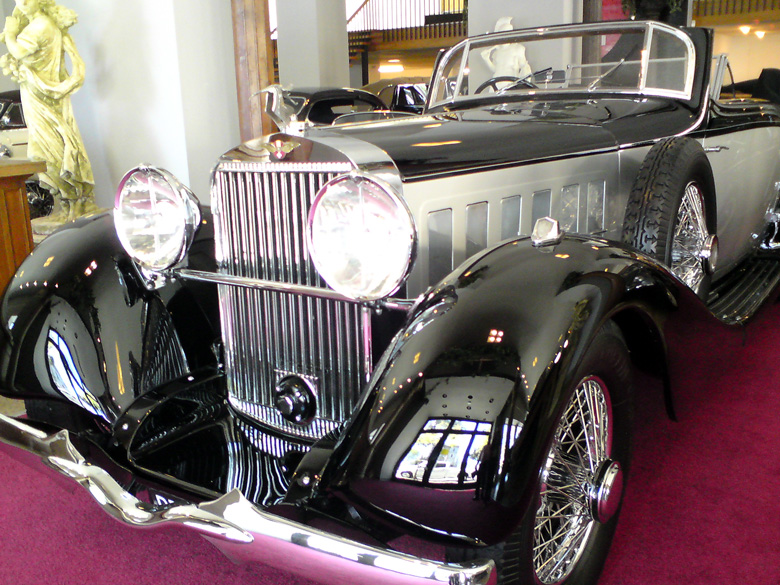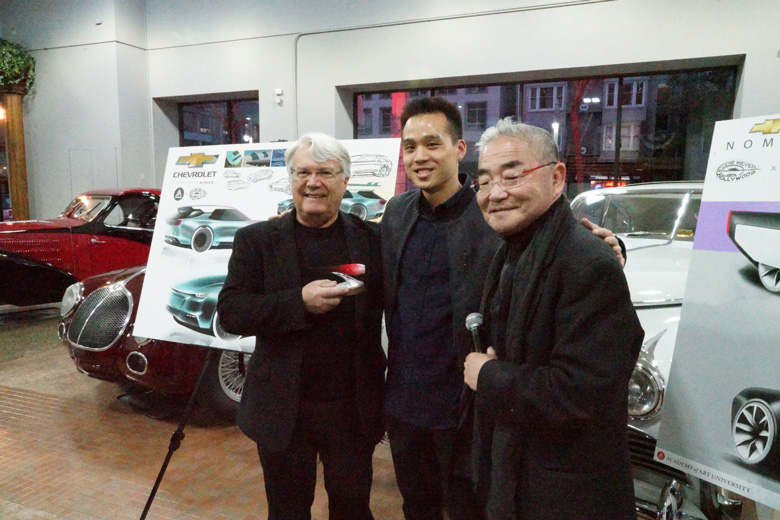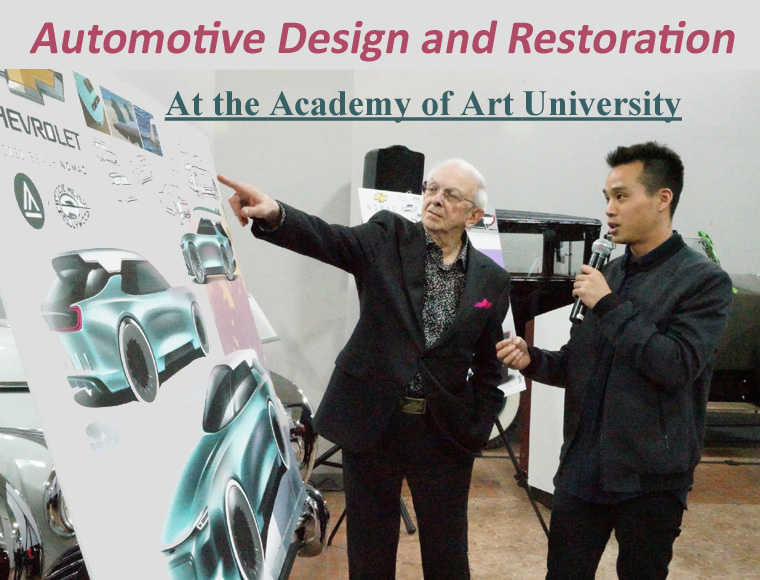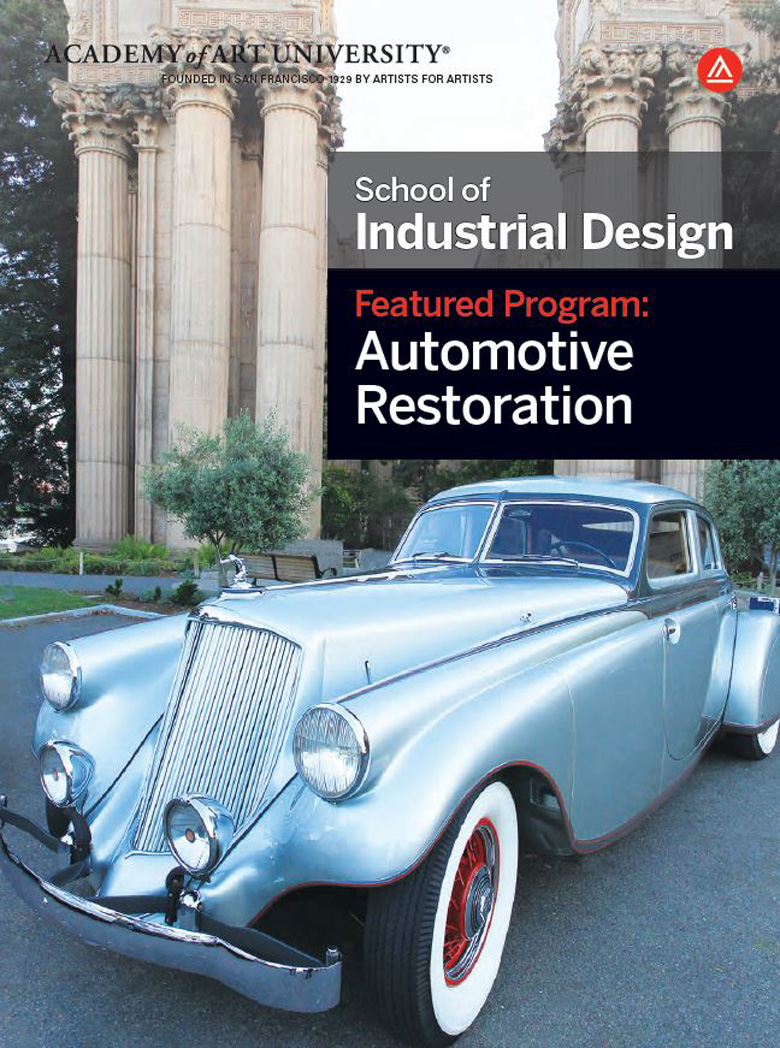Story by Brandes Elitch
I’ll never forget the first time I saw the Academy of Art showroom in San Francisco. I had just come over the Golden Gate Bridge in morning rush hour traffic, which requires quick reflexes and nerves of steel. I went up Lombard and turned on Van Ness, still a little dazed from the drive, which is kind of like open wheel racing. During the twenties and thirties, this is where all the great automobile showrooms were located, and some of them still exist today in their mostly original form. At the intersection of Van Ness and Washington, I idly looked to my right and saw a mirage: a thirties showroom with period cars in the showroom window, except that they were not like any cars there before – Bugatti, Delahaye, Delage, Alfa Romeo, Minerva, Daimler, Duesenberg, Packard – it looked like the lawn at Pebble Beach. I was transfixed, and then rudely summoned from my reverie by a horn in back of me. What is this place, I wondered.

Hispano Suiza with a stunning dual cowl phaeton,by D’Iteren Freres is one of the prize cars of the San Francisco Academy of Art. This was found in the storefront windows of a buidling on Ven Ness and Washinton. Photo by Petya Elitch. Read more
The Academy of Art University Museum is located at 1849 Washington Street and is one of a handful of schools with a program in Automobile Design and Restoration. The school was founded in 1929 by Richard S. Stephens, a fine art painter and creative director for Sunset Magazine. He taught a new and much needed discipline: advertising art. Today it is the largest accredited private university of art and design in the country, with about 14,000 students. The Industrial Design program prepares students to be an automotive/transportation designer and there is a separate program leading to an AA degree in automotive restoration, a much needed discipline today. Today the Academy is ranked as fourth in the Red Dot World Ranking of Industrial Design schools.
I would imagine that many VeloceToday.com readers (including me) wanted to be car designers at some point in their life. This is a discipline where many are called but few are chosen. I was not one of them. It is one of the most competitive design careers. To work in a car studio, you would need a degree in Transportation Design, and while there are a few hundred design schools that offer courses in Industrial Design, there are less than two dozen that specialize in automobile design. Interestingly, the ratio of engineers to stylists at a car company is about twenty to one, so jobs are rare. It is a lifetime commitment and it requires a driving passion. There are perhaps 2000 car designers worldwide.
Needing no introduction, Dick Ruzzin

Dick Ruzzin compliments the designers for the quality of their work and their enthusiasm. Photo by Bob Toy
On April 12 I attended an awards ceremony at the school, during which five students presented their submission for the $10,000 Eddie Myer Scholarship award. The winner was chosen by one of the great designers at GM during the years when GM ruled the industry: Dick Ruzzin, who started at GM in 1961. (Read Ruzzin’s Art and The Mangusta.) Dick was Director of Design for Chevrolet and also worked at the Advanced Olds studio under Dave Holls, worked for Clare Mackichan on the X-car project, as well as working for GM Europe and as Head of Cadillac styling. He also started the Eyes on Design Concours 31 years ago. Dick is also known to our readers because of his book, Bella Mangusta, The Italian Art and Design of the De Tomaso Mangusta. During his career, Dick has worked all over the world on over 140 design programs. He is also a very good speaker and he held the audience in the palm of his hand during his presentation. Dick explained that a car designer has to have an undeniable understanding that their design can be made but it doesn’t exist yet anywhere, and they alone have to make it real – that is what the best designers do. Ruzzin also had a good time. “I had my computer there with my over 200 sketches from 1965 to 1980 and went over all of them with the students, actually that was the most fun,” he said.
Tom Matano
The Executive Director of the Industrial Design program is Tom Matano, one of the most famous car designers in the world today, particularly for his work at Mazda from 1983 until 2002, when he joined the faculty here. Tom was graduated from the Art Center School in Pasadena, and recruited by Chuck Jordan at GM to come to Detroit. He also worked at Holden, the Australian GM subsidiary and then, wanting to experience the European design climate, he worked for BMW in Munich. He was hired at Mazda to be Chief Designer and held a variety of positions there, including General Manager of Design, in charge of all the company’s Chief Designers. Tom is famous for two designs: the Miata and the 1993 RX 7. Tom is modest and charming, and it is certainly his knowledge and charisma (and contacts) that have bolstered this program of instruction.

From left, Mark Eskander, winner of the Eddie Mayer Competition, Kevin Chen, and Tom Matano. Photo by Bob Toy
Tom is an icon in the car design profession. At the beginning, he quit engineering school in Japan after a disagreement with a professor, and then left Japan, taking a cargo ship to Everett, Washington, a place he had never heard of before that. He arrived in September, 1970, and took beginner art classes. As he tells it, “I drew flowers and fruit but the teacher wasn’t satisfied. He asked what else I could do, and I said I’d made some drawings of cars.” From there, it was no looking back. Back in 1974, Dick Ruzzin was Tom’s first boss at GM! Dick told the story that when Tom got his first paycheck after two weeks, he went to Dick and said that he really didn’t deserve the money because all he did was sketch car designs! Fortunately, Dick set him straight.
Dick said that when he interviewed at GM styling, he was told that only one in 200 applicants was chosen! He was working at Fisher Body at the time, and to apply at Styling corporate rules required that he quit his job there first before applying at Styling – talk about being passionate about your career!
Lone designer or team effort?
One of the most interesting things from listening to Tom and Dick is the emphasis on how much of a team effort automobile design is. Dick talked about the small teams he worked in at GM, the clay modelers, the artists, the engineers, the platform designers, etc. They worked in some cases 24 hours a day, seven days a week, sleeping in cots in the hallway and bringing in their food before there was a cafeteria for them. Here, innovation isn’t created by a lone genius – it takes a whole team of people with different backgrounds and perspectives. Ideation is a process of intense collaboration.
Today’s students have to know how to sketch, create digital models, know graphic design, and how to create a web presence. They draw by hand, of course, but they also use a digital sketch tablet with CAD software. They learn 3D printing and how to use a 5-axis CNC milling machine. Tom adds that clay is still the best medium to “capture beyond a computer screen.” He adds, “If it’s going to be used by human hands, it should be crafted by them!”

Ruzzin listens as Chen explains his design for a new Chevy Nomad. Chen’s work was very impressive. Photo by Bob Toy
The occasion on Friday was the fourth annual Eddie Myer scholarship award from the Bud Myer Charitable Trust. The Myer family is hot rod royalty. Eddie started a speed shop in Hollywood that made speed equipment for flathead Ford motors that is very collectible today (in fact, Don Orosco of Monterey, CA made limited edition replicas of the Myer manifolds and heads). Son Bud started working for his father at age 12 in 1930. Eddie sold the business to Bud in 1973, and Bud ran it until 2002. Bud was also a National Champion Hydroplane boat racer, and his uncle, Lou Myer, won the Indianapolis 500 in 1928, 1933, and 1936 – and later built the Myer-Drake Offys, racing royalty indeed
For this competition, five students presented their take on what a 1957 Chevrolet Nomad station wagon would look like if designed today. They were all quite different and all excellent, as you would expect. In accepting the award, the winner told the audience that he could not have done it without the help and guidance of his fellow students in the program, which I thought was pretty impressive.
Car restoration program
Tom gave me a tour of the museum and the instruction areas. One of the things he was most proud of was the relatively recent program of car restoration, which is headed up by Lloyd Buck. Lloyd is pretty well known here in the Bay area from his restoration work at the Keller Collection in Petaluma, which is certainly a world class assembly of perhaps 200 of the rarest and most desirable cars of the classic era. Lloyd joined the school in 2012, and is now Associate Director of this program. It teaches the students woodwork, machine work, sheet metal work, upholstery work, systems knowledge, and the process of research and assembly/disassembly. They make accurate technical drawings and learn to repair, replicate, and sculpt auto body panels too. There are 21 courses in this program.
Anyone who has attended car shows in Northern California will know that the Academy of Art typically fields cars that are show-stoppers. In the showroom last week was a 1939 Alfa Romeo 6C 2500 SS Berlinetta Aerodynamica 1939 LeMans replica, built by perhaps the most famous name in period Italian carrozzeria, the late Sig. Carlo Felice Anderloni, Director of Touring Superleggera. Anderloni created this replica in 2001, one of about 33 cars built for racing. To anyone with even a rudimentary knowledge of historic automobiles, the 6C and 8C Alfas of this period would have to rank on anyone’s Top Ten list of the greatest cars of the era, or any era for that matter. Other cars in the showroom included a 1927 Minerva with a LeBaron body, a 1937 Bugatti Type 57 Atalanta coupe, a 1937 Delage D8 Chapron convertible, and a spectacular 1949 Delahaye type 175 coupe de ville with a Saoutchik body built for the 1949 Paris Motor Show. These are only a small portion of the total collection.
When I met with Tom, I had to ask him about his favorite cars on the floor and outside the building. In the collection is a Squire, one of only seven made. He loves the way the door hinge was designed. His favorite personal car is a 1967 De Tomaso Vallelunga, one of about 53 made. The Vallelunga has a backbone chassis and weighs only 1600 pounds. You can certainly see why the Vallelunga would be a stylist’s choice.
In closing, I asked Tom about design trends today, where many vehicles look like an angry kitchen appliance (to steal a phrase from Bob Lutz). Tom asked if I wash and wax my own cars. He said that if the designer did that simple thing, he would avoid the “hand traps” that are so prominent on modern cars, because your hand should flow naturally over the surface, just like any sculpture. Of course, if you had a Vallelunga, you would want to wash and wax it every weekend.
Thanks to Tom for his gracious hospitality and for the University to host this delightful evening.
School-of-Industrial-Design-Automotive-Restoration-Program-Brochure



It’s not often that you can meet with and talk about automotive design with men like Dick Ruzzin and Tom Matano who created some of the world’s great kenetic icons in metal. Thanks so much for telling us about San Francisco’s Academy of Art Museum; what a treat! And then to be able to sit in on discussions for both the creative side… design and the “recreation” of rare classics in metal…in Lloyd Buck’s restoration shop! For anyone really interested in design just having the opportunity to work on or observe the process of restoration on a classic is a special privilege. There are only a handful of places on earth that teach automotive design but only the Academy of Art offers both the opportunity to learn design and the art of hands-on restoration from the masters.
I was 16-17 when I first saw several Mangusta’s in a car showroom in Auburn Massachusetts. They were all Series-1, the Boss 302 engine-ed, aluminum bodied cars. It was the size….the form….the mid engine that got me, but the color combinations that took my breath away! By that age I had rebuilt/restored my very first car – an Alfa Giulietta 1300 Normale. I loved the grease under my fingernails! I learned a lot from that exercise. [still haven’t gotten my fill some 50 years later – I’m resorting 4 Italian cars at once!].
The creativity of deign, execution and realization of physical form does not happen for everyone. Sure, I did my time with car design [realizing only now – 60 yrs on – that I was reinventing the wheel]. Eventually, I became an Architect – designing commercial high-rise buildings.
Those Mangusta’s I saw 50 yrs ago still haunt my dreams. I will never forget that!!
It is a real pity that the USA didn’t realize the value that “Shop” classes had in the education of our youth. I gather that many programs were junked and the facilities converted for other use. How a country can be a leader in manufacturing and design when such a high percentage of your youth are only interested in computer related and social media activities, and aren’t encouraged to do otherwise, is beyond me.
In British Columbia, we had to really fight to keep facilities and programs operational, but then when the premier realized that tradespeople were in very short supply with this having a real impact on industry, there was all of a sudden a change in attitude!